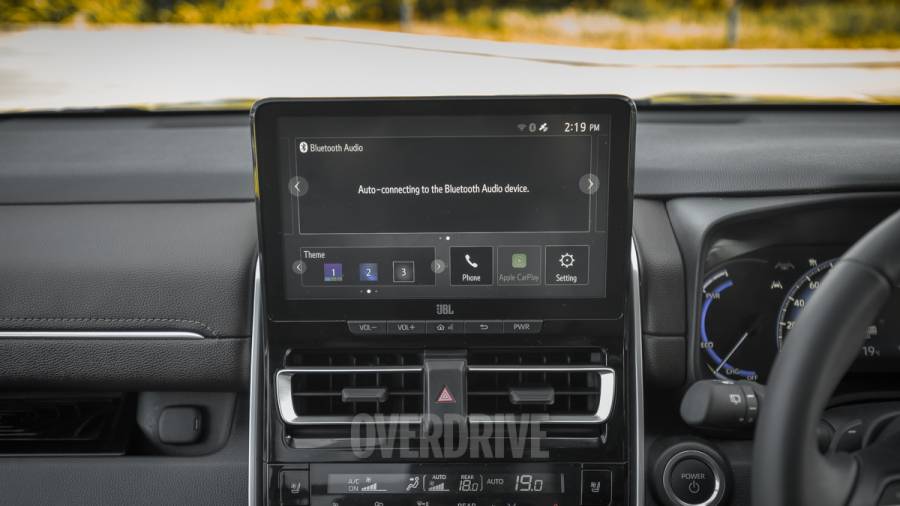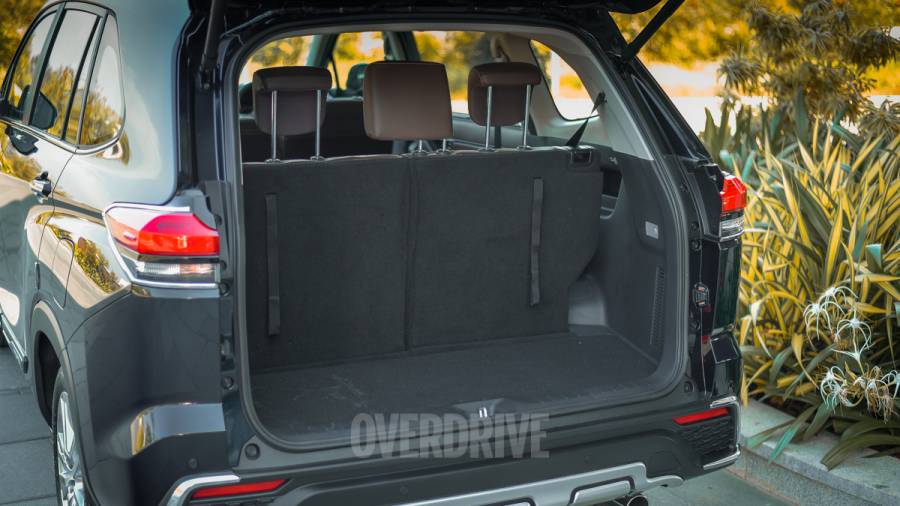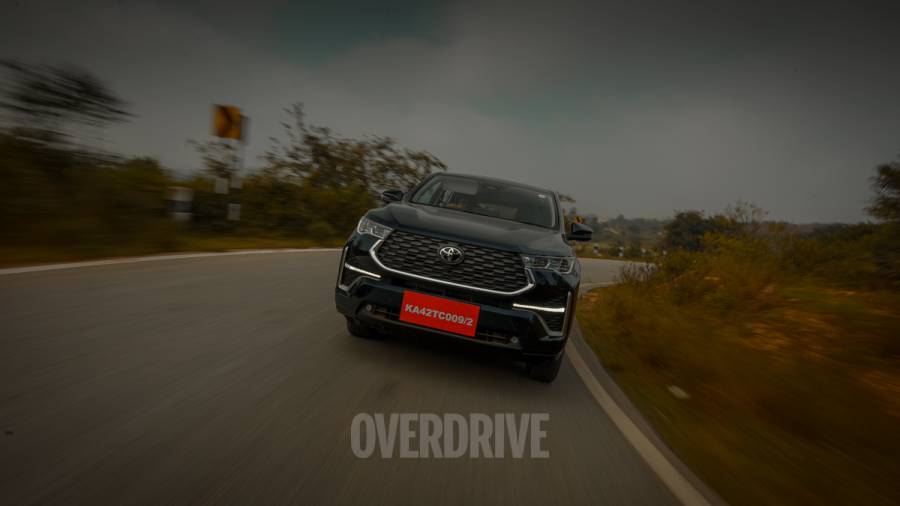Toyota Innova Hycross review, first drive - still an Innova in the truest sense?
Why would you want to reinvent a winning formula? The Toyota Innova has been as successful a recipe as it gets, so it's quite surprising to see Toyota completely reinvent it with the Toyota Innova Hycross. But the gains in efficiency with a hybrid powertrain as well as a more spacious cabin seem to have been the biggest draws in this move to a front-driven, monocoque architecture from the rear-driven, ladder-frame bones of the Crysta. But is the Hycross still an Innova in the truest sense?
Toyota Innova Hycross exterior, dimensions
The Toyota Innova Hycross is only about 20mm longer and wider than the Crysta but of the same height. Despite these minor increases, the Hycross looks quite a bit more substantial in person, with the wider tracks, the 100mm longer wheelbase and the shorter overhangs.

The added presence also comes from the strong SUV cues that Toyota has gone with for the Innova Hycross. The front is still recognisably an Innova but the grille has been made larger, and the headlamps are now LEDs in a sharper, more condensed design. The sense carries through with the connected air dam with the large housings for the DRLs and with the much more heavily contoured bonnet.

The SUV theme is also seen in profile where the glasshouse has been refined to drop down after the C-pillar. The shape of the Hycross itself is functional with a large glasshouse and doors but the bodywork has now been accented by prominent creases over the fenders and the rear haunches. The 18-inch wheels further add to this sense. Ground clearance remains unchanged from the Crysta. There's a more raked rear windscreen again while the tail-lamp unit's wider shape is directly inspired by Toyota's current SUVs.
Toyota Innova Hycross interior, features, practicality
The Toyota Innova Hycross is now based on the TNGA-C high architecture which it shares with Japanese market MPVs like the Noah and Voxy. This crucial shift is most apparent when you first step inside the Hycross. The cabin is nothing like the simple, functional ones we've seen before in an Innova. The horizontally-themed dash is again quite SUV-like, with its large free-standing central screen and more ergonomic layout. The quality of materials has also improved noticeably with the soft brown surfaces on the dash face and doors as well as the quilted upholstery. The switchgear feels better damped and the hard plastics, though still with that typical hard-wearing texture you are accustomed to in a Toyota, seem better tempered by the new design.

Functionally this is also a more spacious and practical space. Yes, climbing into the driver's seat is a bit of a trek considering the hybrid system packed underneath results in a high floor. But once here there is great visibility for the driver, the bulges on the bonnet are clearly visible while the front quarter glass has been enlarged and the window line lowered. The new steering wheel is tilt and telescopic adjustable while the driver's seat is powered so finding a comfortable driving position is easy.

The front seats themselves seem wider and more supportive and you get them with the much-loved ventilated function, although these could have been a touch more effective at their lowest, quietest speed. Even the footwells are larger than before. If anything, we would have also liked a powered front passenger seat or at least a more accessible sliding lever on the seatback as you find in certain cars like the Superb.


Bucking recent trends, Toyota specifically ensured that there are hard buttons for pretty much all of the Innova Hycross' functions. So you get tactile buttons for the climate control as well as for all the driving and ADAS functions. The dash-mounted gear lever has also opened up space for large cup holders, well-placed charge ports and a deep central bin. The door pockets too are quite useful for carrying small items.


You control most information through the 7-inch MID which has crisp graphics and logical menus. As for the 10.1-inch screen, it's an improvement over the one in the Crysta for sure and is quite responsive but only controls your phone and audio functions. We would have liked crisper graphics here as well as wireless Android Auto/Apple Carplay.

There's quite a long list of features to go with this. Wireless charging is an accessory but you get LED lighting, auto-headlamps, auto wipers, powered mirrors, 9-speaker JBL audio, ambient lighting, connected tech, and a panoramic sunroof.
Toyota Innova Hycross second row, third row, boot
The second row is possibly the most important part of the Innova Hycross' cabin, so it isn't surprising that Toyota has pulled out all the stops here. The Hycross can be had as an 8-seater with a second-row bench or as a 7-seater with the two captain chairs as seen here. These chairs again give you great thigh support and well as pliant cushioning but the big improvement has come with the space that's on offer.

The 100mm increase in wheelbase over the Crysta has freed up significant knee room and better space management means that even with the panoramic sunroof, headroom will be adequate for all but the tallest of passengers. A noticeable drawback though is that with the battery pack now placed under the front seats, foot room can be comprised if you are tall and carrying passengers in the third row.


That said, the party trick here is the powered seatback which will recline to a near-flat position as well as the powered ottomans. This shores up comfort significantly and should be great on those long inter-city trips. But again the constricted foot space means your feet will more often than not jab against the front seatback, despite the long range of travel for these captain seats. This isn't exactly a deal-breaker though, considering the significant overall improvement. Either way, this space feels large and airy with the big windows and sunroof. You get a separate climate zone, a collapsible centre tray as well as sunshades to fully drive home a sense of luxury here.


The space efficiencies of a monocoque architecture have also worked to the advantage of the Innova Hycross' third row. Things don't start all that well though. The more complex second-row seats don't tumble anymore so getting in and out of the third row is more difficult than before. But the lower floor has raised the hip point for the last bench. So you sit less crouched than before. Thigh support is about as good as it gets in these seats and the bench is wider. It'll even recline to a comfortable angle.


Toyota calls this space good for three, you even get a third headrest and three-point seatbelt, but that'll only be true for children. Although two adults should be comfortable over fairly long distances. You get air vents here, as well as cubbies and cup holders although there is a single 12V charge outlet unlike the USB ports for the front two rows.


With all three rows up, there is about as much space for luggage as in the Crysta. But you now get a smaller hidden compartment under the floor for small items. Usefully, the third-row seats fold fully flat, opening up a significant 991 litres of boot space. The load lip isn't too high and the space is flat and square so usability shouldn't be a problem.
Toyota Innova Hycross hybrid drive impressions
Another fundamental shift that the Toyota Innova Hycross brings with it is that it's now available only as a hybrid or as a petrol. There's no diesel anymore, a core ingredient in making the Innova as successful as it has been.

The hybrid Hycross uses a 2.0-litre Atkinson cycle petrol motor that puts out 154PS and 190 Nm paired with a 113PS and 206 Nm electric motor, with an e-CVT in the mix for a combined 186PS. Lower-spec models get a 2.0-litre naturally aspirated petrol with 174PS and 202 Nm, again paired with a CVT.

As with all of these Toyota hybrid systems, the Hycross will usually start in EV mode. So you get going smoothly and silently. The petrol motor does cut in quickly enough, but it does so seamlessly and fairly quietly. This makes the large MPV feels quite adept in traffic, having that linear electric torque to keep up momentum at all times. It'll keep filling gaps in the ICE powerband and help the CVT function more seamlessly. The Eco, Normal and Power modes don't alter outputs so even in the most conservative setting, the Hycross is perfectly usable.

You then realise that the Innova Hycross is a fairly brisk machine, the 0 to 100 kmph claim of 9.5s seeming quite believable. You will miss that swell of diesel torque that brings with it a more familiar sense of progress, but this is replaced by a wider, more consistent supply of performance. Yes, there is some of that CVT drone but you still have forward motion so the effect isn't as stark as it could have been without the electrical assistance. You get a sport mode for the gearbox as well as paddles for simulated ratios but these don't alter the experience significantly. The Hycross could have had better high-speed overtaking ability too, at part-throttle there isn't enough torque to make quick passes as say a similarly powerful diesel.

Here we also would have liked a Braking mode for the gearbox. There is some engine braking effect built into this powertrain but the near one-pedal function this provides in the Hyryder would have been a good fit for the Hycross too. We also would have liked the brake pedal to have a bit more feedback initially, but you get used to the early dead spot in its travel eventually.
But we think the notable gains in efficiency should cover these minor drawbacks. Over 14 km of fairly heavy driving over a mixed route we saw over 16 kmpl. Not near the 21.1 kmpl claimed figure but still far ahead of the diesel Crysta.
Toyota Innova Hycross ride and handling impresssions
A significant change has come about in the way the Toyota Innova Hycross carries itself with this shift. The MPV is now a far quieter, more relaxed place to spend time in. Wind and tyre noise is very well controlled by any standards, far ahead of previous Innovas and no real vibrations or noises are come through from the drivetrain either. So longer journeys will be more relaxing.

Yes, the Hycross can't quite dismiss the worst our roads have to offer as well as a ladder-frame alternative though. Sharp potholes or big bumps, which would barely register in the Crysta, are more apparent but things improve from here. A sense of solidity is always present though, and the smaller wheels in the lower trims may soften this trait. But pick up pace and its business as usual. The Innova Hycross feels planted at high speeds, with little float or slack. The ride smoothens out very well here too, so again long-distance comfort will be a big positive.

This sense is further enhanced by the way the Hycross handles. Far from feeling wallowing, the new Innova feels quite adept around a winding road. Body roll is kept in check and the long wide car does a good job of hiding its mass here as well as if not better than similarly sized SUVs. This sense is further enhanced by the steering tune. It's not overtly light at city speeds but feels precise. This sense only grows at higher speeds where you always feel in tune with the car's motions.
Toyota Innova Hycross ADAS, safety
You can option the Innova Hycross with Toyota's level 2 ADAS equipment. This system has been tuned for India and seems to be quite effective in our conditions. It picks up even faint lane markings easily enough and tackles sweeping highway corners naturally too. It's also not too highly strung in its interventions but will still give you clear warnings when it wants you to take full control. The adaptive cruise control also functions intuitively, keeping reasonable gaps and speeding up and slowing down fairly naturally.
As for passive safety equipment you get six airbags, TPMS, hill start assist and an electronic parking brake. There is a 360-degree camera too but its grainy feed limits its functionality.

Toyota Innova Hycross verdict, expected price
The Toyota Innova Hycross will be an expensive proposition, expected to be priced between Rs 22 to 30 lakh, but it is clear that this really is what a modern Innova should be. Yes, you lose some of the earlier defining traits like the diesel performance and the last degree of rough-road ability. But that is replaced by a far more efficient, as well as an easier, more relaxing experience. Further enhanced by a generally more useful and feature-packed cabin and eye-catching looks.
Text: @tuhinguha
Images: @anis.shaikh.media
Also read,
Toyota Innova Hycross Vs Innova Crysta: What's changed?
Spec comparison: Toyota Innova Hycross Vs Kia Carnival
Toyota Innova Crysta to be sold alongside Hycross
Starts Rs 24.95 Lakhs
2143cc
Automatic
200
440
-NA-
Starts Rs 16.26 Lakhs
2694cc
Automatic
150
245
-NA-
Related Stories
Top Stories
Latest Videos
Most Popular
- Maruti Suzuki Fronx Drive Feature: Switch to Plan B
- Ford India to make a comeback in 2025? New-Gen Endeavour design patented in India
- Maruti Suzuki Brezza emerges as the most successful SUV of 2023
- Nissan Magnite EZ-Shift review - is the AMT any good?
- Hyundai Creta facelift bookings open for token amount of Rs 25,000













